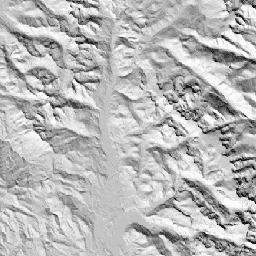
- در دسترس بودن مجموعه داده
- 2006-01-24T00:00:00Z–2011-05-13T00:00:00Z
- ارائه دهنده مجموعه داده
- همکاران علم حفاظت
- برچسب ها
توضیحات
CHILI جایگزینی برای اثرات تابش و سایه توپوگرافی بر تبخیر و تعرق است که با محاسبه تابش در اوایل بعد از ظهر، ارتفاع خورشید معادل اعتدال نشان داده می شود. این بر اساس 10 متر NED DEM USGS (در EE به عنوان USGS/NED موجود است).
مجموعه دادهها، لندفرمها و فیزیوگرافی شرکای علم حفاظت (CSP) ژئومورفولوژی مرتبط با محیط زیست (ERGo) حاوی دادههای دقیق و چند مقیاسی در مورد شکلهای زمین و الگوهای فیزیوگرافیک (معروف به زمین) است. اگرچه استفادههای بالقوه زیادی از این دادهها وجود دارد، اما هدف اصلی برای این دادهها ایجاد یک طبقهبندی و نقشه مرتبط با محیط زیست از شکلهای زمین و کلاسهای فیزیوگرافی است که برای برنامهریزی سازگاری آب و هوا مناسب هستند. از آنجایی که عدم قطعیت زیادی در ارتباط با شرایط آب و هوایی آینده و حتی عدم اطمینان بیشتر در مورد واکنشهای اکولوژیکی وجود دارد، ارائه اطلاعات در مورد آنچه که تغییر محتمل نیست، پایهای قوی برای مدیران ایجاد میکند تا برنامههای سازگاری آب و هوایی قوی ایجاد کنند. کمی سازی این ویژگی های چشم انداز به وضوح حساس است، بنابراین ما بالاترین وضوح ممکن را با توجه به وسعت و ویژگی های یک شاخص ارائه می دهیم.
باندها
اندازه پیکسل
10 متر
باندها
| نام | حداقل | حداکثر | اندازه پیکسل | توضیحات |
|---|---|---|---|---|
constant | 0 | 255 | متر | شاخص CHILI مشتق شده از NED از 0 (بسیار سرد) تا 255 (بسیار گرم) متغیر است. این از محدوده [0،1] در نشریه تغییر مقیاس داده شد. |
شرایط استفاده
شرایط استفاده
نقل قول ها
Theobald، DM، Harrison-Atlas، D.، Monahan، WB، & Albano، CM (2015). نقشههای مرتبط با محیط زیست از شکلهای زمین و تنوع فیزیوگرافیک برای برنامهریزی سازگاری آب و هوا PloS one, 10(12), e0143619
با Earth Engine کاوش کنید
ویرایشگر کد (جاوا اسکریپت)
var dataset = ee.Image('CSP/ERGo/1_0/US/CHILI'); var usChili = dataset.select('constant'); var usChiliVis = { min: 0.0, max: 255.0, }; Map.setCenter(-105.8636, 40.3439, 11); Map.addLayer(usChili, usChiliVis, 'US CHILI');
